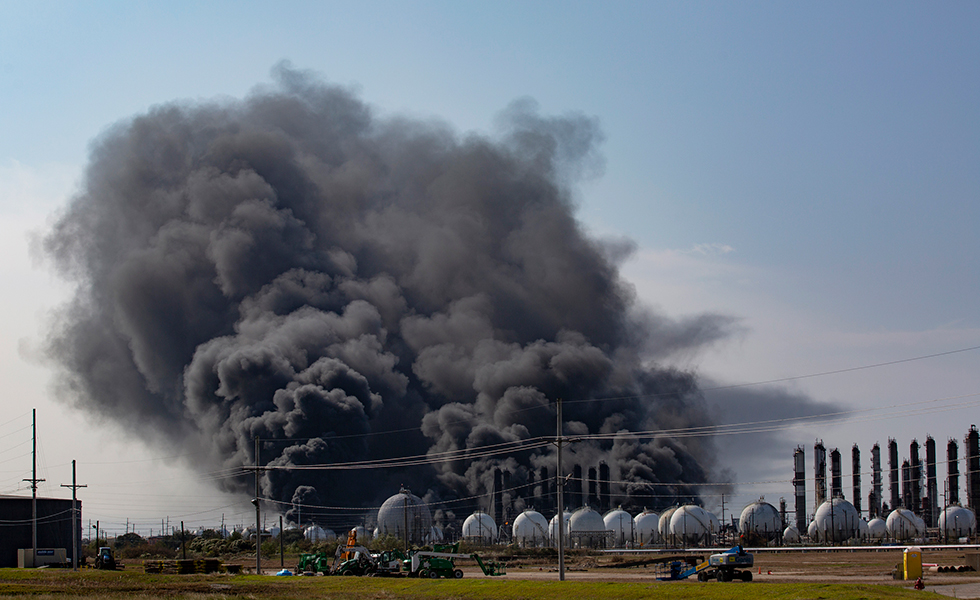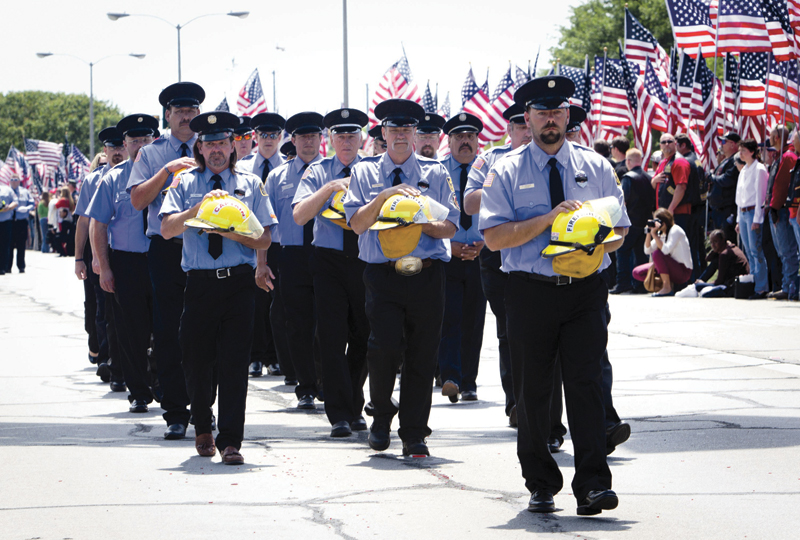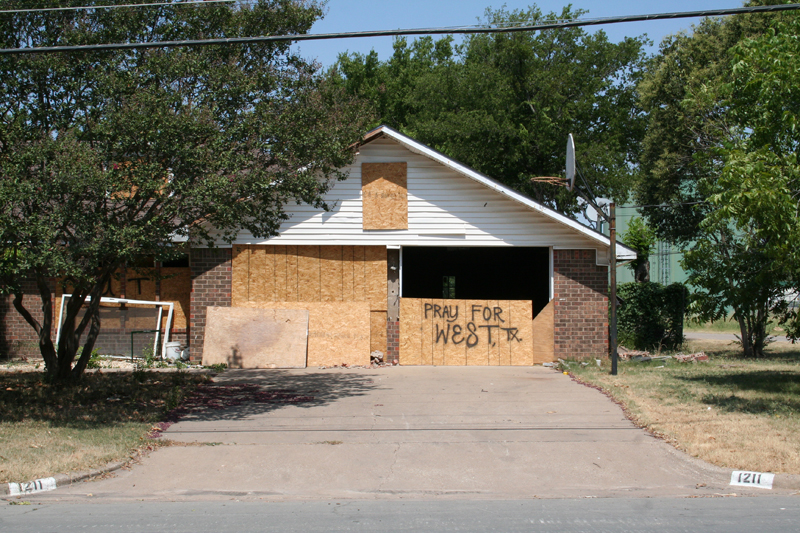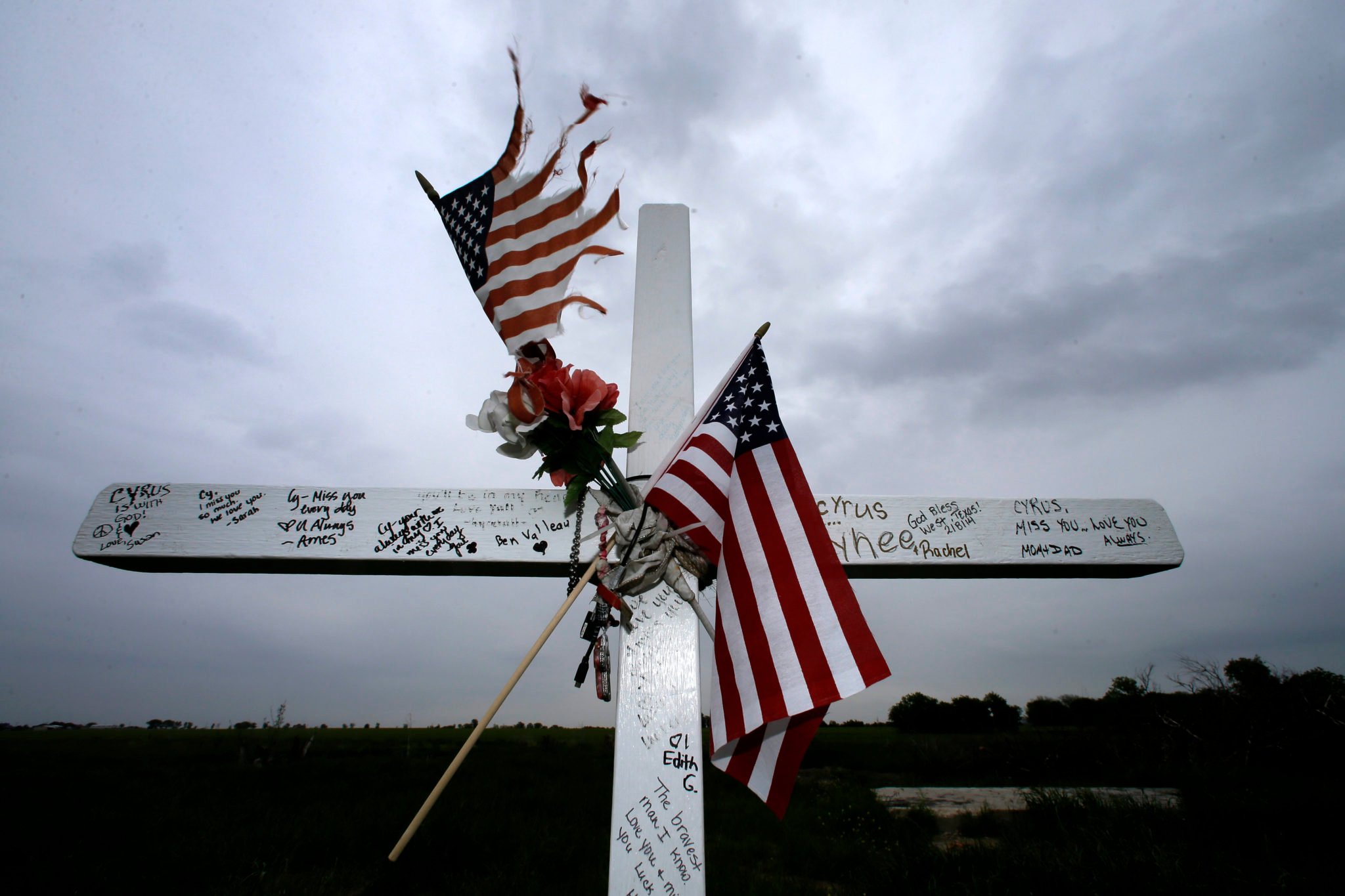
West, Texas Blues
Two years after the West fertilizer plant disaster, few ammonium nitrate facilities have made critical changes.
Above: A cross with messages to one of the victims of the fertilizer plant explosion sits planted in an open field across the street from the site of the explosion.
On March 17, 2014, an inspector from the State Fire Marshal’s Office arrived in Athens, Texas, to take a look at East Texas Ag Supply, a fertilizer storage facility located just a few blocks from the historic Henderson County Courthouse.
The visit was part of a second round of voluntary inspections of ammonium nitrate facilities conducted by the state fire marshal in the wake of the West disaster on April 17, 2013. Like his counterparts across the state, the inspector had been dispatched to assess whether the dozens of ammonium nitrate plants in Texas had made progress in fixing some of the problems that contributed to the West fire and explosion that leveled parts of the town and killed 15 people.
But it appeared that little had changed. In his report, the inspector noted that 135 tons of bulk ammonium nitrate was stored in a wood-frame building and in a bay constructed of wood, considered to be a serious fire risk by experts. The fire at the West Fertilizer Company plant began in a wooden warehouse, and ignited ammonium nitrate stored in wooden bins. The only fire protection at the Athens plant was two portable fire extinguishers. Like the West plant, it had no sprinkler system, a hazard noted in a 2013 inspection, too.
Six weeks later, the facility erupted in flames, necessitating an evacuation of part of the town. The cause of the fire was never determined; luckily, the ammonium nitrate didn’t ignite.
In 2004, an ammonium nitrate facility owned by the El Dorado Chemical Company burned down in Greenville. In 2009, another El Dorado plant burned to the ground in Bryan. The company rebuilt the Bryan facility, opting for a non-combustible concrete structure. After the West explosion, John Carver, an El Dorado vice president, told the Dallas Morning News it had hired an engineering firm to assess risks at its facilities. Around the same time, a company spokesperson assured a North Texas news channel that its materials were “housed in a way that does not pose a threat to the public.” But as inspection reports from 2014 show, the company hadn’t fixed many of the major issues with its facilities, including the housing of ammonium nitrate in wooden structures.
In the tiny town of Whitewright in North Texas, an El Dorado fertilizer plant is located less than a quarter-mile from the town’s high school. According to a May inspection, ammonium nitrate is housed there in damaged wooden structure that lacks a sprinkler system. Although the West disaster had focused attention on the potential for ammonium nitrate plants to be a deadly threat, and the state fire marshal discovered plenty of problems at El Dorado’s facilities, not much had evidently changed.
In the two years since the explosion in West, the state fire marshal has inspected every ammonium nitrate facility in Texas twice, identifying recurring problems at dozens of fertilizer dealers and plants similar to the one in West. But an Observer review of partially redacted fire safety inspection reports obtained through open records law has found that few facilities have made basic changes recommended by the fire marshal. And lawmakers haven’t made a single change to the oversight system.
Of the 92 facilities in operation in 2014, only one-fifth had a sprinkler system. Fifty-two facilities had no means of fire protection other than portable fire extinguishers, while 22 were described as having no fire protection features at all. Fire extinguishers and sprinkler systems are important features, said State Fire Marshal Chris Connealy, in order to put out incipient fires, before they become unmanageable. Today there are 83 ammonium nitrate facilities operating in Texas, many located in populated areas. Buddy’s Plant Plus in Ballinger is located across the highway from Ballinger High School. Lawrence Farm and Ranch Supply in Cross Plains is situated nears homes and businesses.
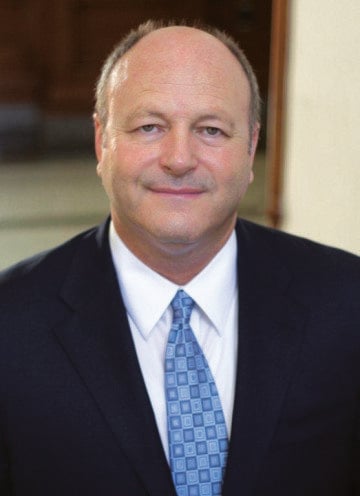
Connealy says he wasn’t surprised when his inspectors found several potential fire hazards at facilities during his first round of inspections in 2013, because so many of them have been around for years and have had little incentive to improve standards. And when he found several potential fire hazards the next year, well, he still wasn’t surprised. The State Fire Marshal’s Office has no enforcement authority over ammonium nitrate facilities, so operators are under no legal obligation to address any hazards found during the voluntary inspections. The reports are essentially just suggestions, and facility managers are often resistant to address them. Moreover, the information in the inspection reports isn’t readily available to the public. The Observer had to file an open records request, wait months, and pay $119 to access documents that are heavily redacted.
Connealy says that ammonium nitrate should ideally be stored in a non-combustible structures—like concrete—and that the storage bins should be changed out when they show signs of the fertilizer lodging in the wood. According to inspection reports, 31 facilities showed signs of product impregnation in 2014.
Rep. Joe Pickett (D-El Paso) has been leading efforts in the Legislature to prevent another West. What has changed since? “Nothing,” he said. Pickett said the fire marshal’s inspections led to some small fixes early on, but that as memory of the West tragedy fades, inaction will set likely set in if a new oversight system isn’t devised.
The cause of the fire that triggered the explosion in West is still unknown, but we do know what was detonated: ammonium nitrate. The West Fertilizer Company was storing up to 540,000 pounds, or 270 tons, of the substance. It isn’t inherently explosive, but when exposed to fire it can be deadly.
In the days and weeks following the explosion in West, investigations revealed that the West Fertilizer Plant didn’t have a security plan or an up-to-date risk management plan. The facility had also filed a report with the Texas Department of State Health Services claiming that it hadn’t stored ammonium nitrate since 2012. The U.S. Department of Homeland Security didn’t even know the facility existed. In short, no one was keeping tabs on the plant.
Since 2007, the obscure Office of the Texas State Chemist has regulated the sale of ammonium nitrate. After the West explosion, the Office of the State Chemist created a few new rules that ammonium nitrate facilities must follow. The rules are pretty limited, pertaining to providing evidence of compliance with reporting procedures, and displaying warning placards. There’s only one new rule that directly removes a fire hazard, one that Connealy says is a “major improvement”: facilities now have to keep ammonium nitrate at least 30 feet away from combustible or flammable material, such as feed, batteries and fuel.
Facilities are required to perform daily inspections to ensure that those rules are being followed. The Office of the State Chemist has 15 investigators who inspect each facility annually, and any facility found to be in violation of the rules will have its registration suspended.
Of the 92 facilities in operation in 2014, only one-fifth had a sprinkler system. Fifty-two facilities had no means of fire protection other than portable fire extinguishers, while 22 were described as having no fire protection features at all.
But Pickett isn’t satisfied with the changes.
“Who’s going to go in from the state chemist to make sure there’s no bare electrical wires, and that you’ve got the right kind of fire extinguisher?” Pickett said. “Well, they’re not. Why don’t we have first responders in there?”
That’s why he’s proposed legislation this session that would give the State Fire Marshal’s Office inspection authority and require facilities to address violations within 10 days of their identification. Pickett’s bill would also allow the Fire Marshal’s Office to create more rules for ammonium nitrate facilities.
Another bill, proposed by Rep. Kyle Kacal (R-College Station) would also give the fire marshal the authority to inspect facilities, but wouldn’t allow him to write rules for ammonium nitrate.
Many ammonium nitrate operators are OK with giving the fire marshal inspection authority, but don’t think that the office should be allowed to write new rules.
During a public hearing at the Capitol in April, Farley Farm Supply owner Jim Farley testified in favor of Kacal’s bill and against Pickett’s. He said that he’s made more changes since the West disaster to his feed and supply store, which sells ammonium nitrate fertilizer, “than in the previous 36 years combined.” He said part of his facility, located in the center of De Leon, a town 100 miles southwest of Fort Worth, had been “completely gutted” so that it would be in compliance with the 30-feet rule.
The 2014 inspection report for the facility found that the wooden ceiling showed signs of product impregnation, and that the only fire protection features were portable fire extinguishers. Farley testified that addressing those issues would be cost-prohibitive.
Raymond Helberg, coordinator of the Comanche County Emergency Management department, which oversees De Leon, says he’s not “overly concerned” about the dangers posed by the facility, and believes that current safety measures are sufficient. After the explosion in West, officials met with Farley and created an emergency plan that primarily focuses on evacuation. Helberg doesn’t think new legislation would help much.
“I don’t think you can get any safer,” Helberg said.
Connealy said his office is waiting to see what changes the Legislature makes, if any, before moving forward with another round of inspections.
Pickett said he doesn’t care which of the bills moves forward this session, only that some kind of action is taken. Kacal’s bill was unanimously voted out of committee on Tuesday, but the prospect of legislation passing dwindles as the session approaches its June 1 end date.
“It will be a matter of time,” Pickett said. “If we don’t do something, we’ll have another West explosion.”
